sensor Lexus ES350 2012 Owner's Manual
[x] Cancel search | Manufacturer: LEXUS, Model Year: 2012, Model line: ES350, Model: Lexus ES350 2012Pages: 554, PDF Size: 6.43 MB
Page 22 of 554
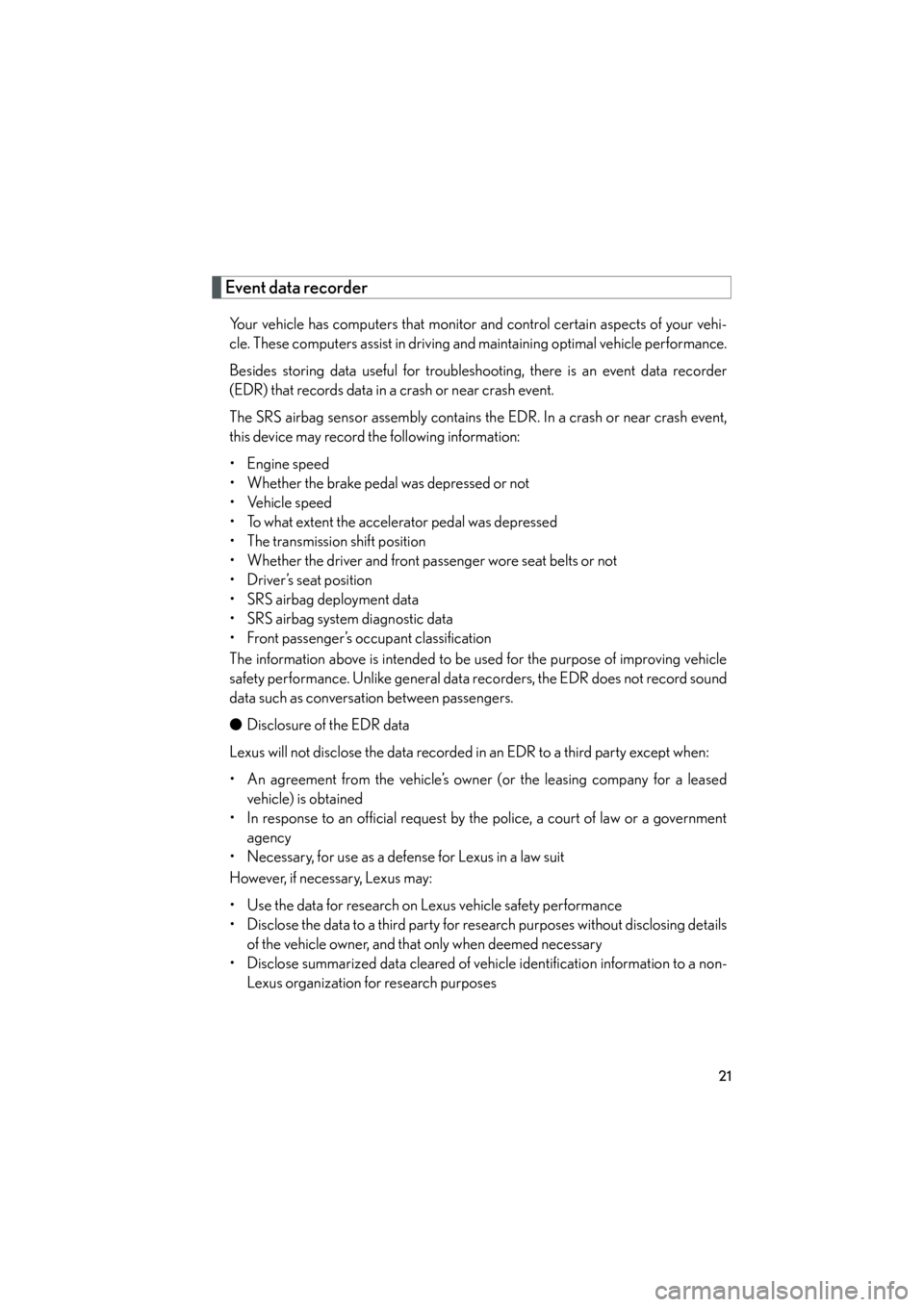
ES350_U
21
Event data recorder
Your vehicle has computers that monitor and control certain aspects of your vehi-
cle. These computers assist in driving and maintaining optimal vehicle performance.
Besides storing data useful for troubleshooting, there is an event data recorder
(EDR) that records data in a crash or near crash event.
The SRS airbag sensor assembly contains the EDR. In a crash or near crash event,
this device may record the following information:
• Engine speed
• Whether the brake pedal was depressed or not
•Vehicle speed
• To what extent the accelerator pedal was depressed
• The transmission shift position
• Whether the driver and front passenger wore seat belts or not
• Driver’s seat position
• SRS airbag deployment data
• SRS airbag system diagnostic data
• Front passenger’s occupant classification
The information above is intended to be used for the purpose of improving vehicle
safety performance. Unlike general data recorders, the EDR does not record sound
data such as conversation between passengers.
●Disclosure of the EDR data
Lexus will not disclose the data recorded in an EDR to a third party except when:
• An agreement from the vehicle’s owner (or the leasing company for a leased vehicle) is obtained
• In response to an official request by the police, a court of law or a government agency
• Necessary, for use as a defense for Lexus in a law suit
However, if necessary, Lexus may:
• Use the data for research on Lexus vehicle safety performance
• Disclose the data to a third party for research purposes without disclosing details of the vehicle owner, and that only when deemed necessary
• Disclose summarized data cleared of vehicle identification information to a non-
Lexus organization for research purposes
Page 30 of 554

29
1-2. Opening, closing and locking the doors and trunk
1
Before driving
ES350_U
Unlocking and locking the doorsGrip the driver's door handle to
unlock the door. Grip the passen-
ger's door handle to unlock all the
doors. *
Make sure to touch the sensor on
the back of the handle.
The door cannot be unlocked for 3
seconds after the door is locked.
*: The door unlock settings can bechanged. (
→ P. 3 3)
Press the lock button to lock the
door.
Pressing and holding the button
closes the windows and standard
moon roof.
Unlocking the trunk
Press and hold the button to
unlock the trunk.
Page 62 of 554
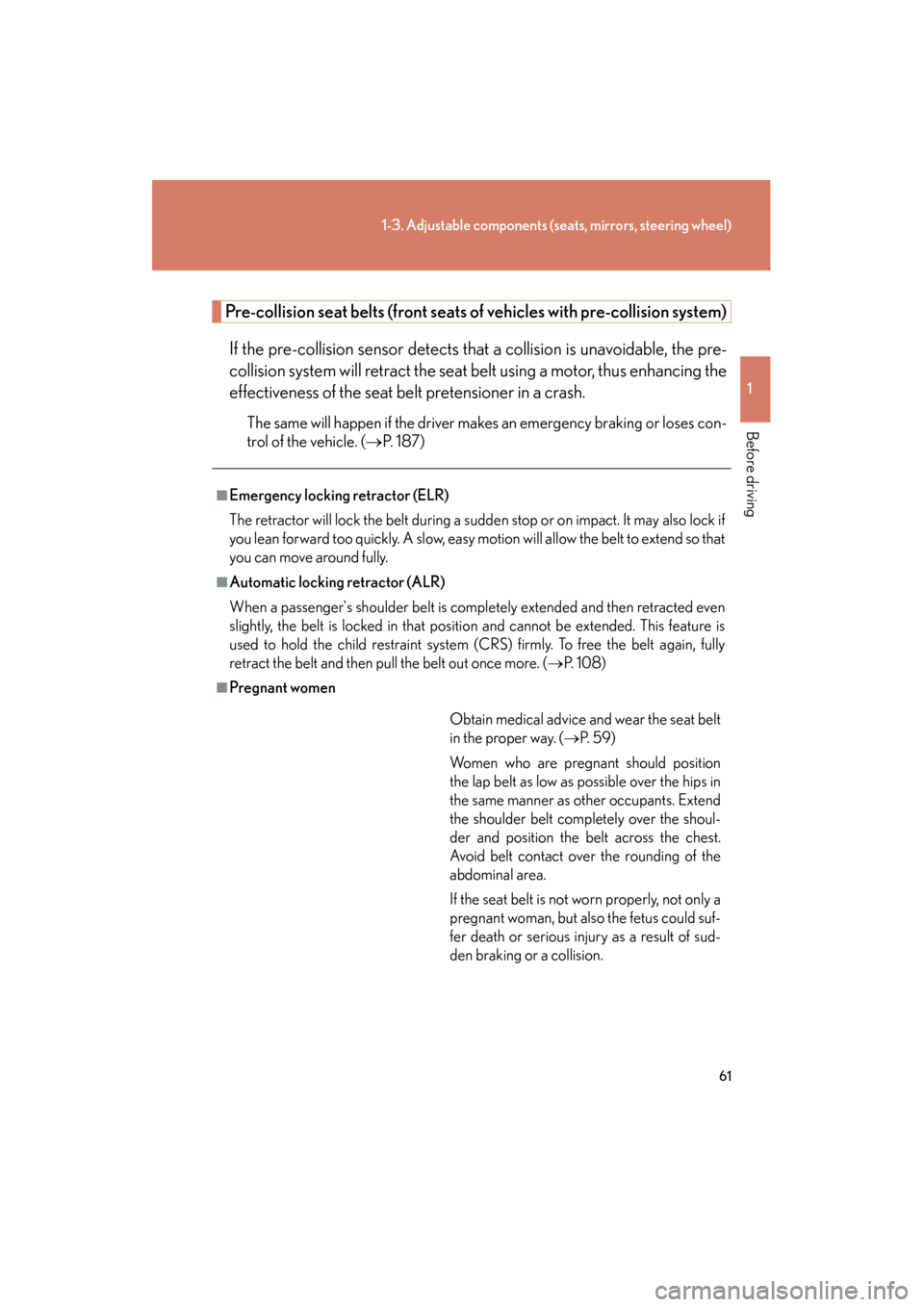
61
1-3. Adjustable components (seats, mirrors, steering wheel)
1
Before driving
ES350_U
Pre-collision seat belts (front seats of vehicles with pre-collision system)
If the pre-collision sensor detects that a collision is unavoidable, the pre-
collision system will retract the seat belt using a motor, thus enhancing the
effectiveness of the seat belt pretensioner in a crash.
The same will happen if the driver makes an emergency braking or loses con-
trol of the vehicle. ( →P. 1 8 7 )
■Emergency locking retractor (ELR)
The retractor will lock the belt during a sudde n stop or on impact. It may also lock if
you lean forward too quickly. A slow, easy motion will allow the belt to extend so that
you can move around fully.
■Automatic locking retractor (ALR)
When a passenger's shoulder belt is completely extended and then retracted even
slightly, the belt is locked in that position and cannot be extended. This feature is
used to hold the child restraint system (CRS) firmly. To free the belt again, fully
retract the belt and then pull the belt out once more. ( →P. 1 0 8 )
■Pregnant women
Obtain medical advice and wear the seat belt
in the proper way. (→P. 5 9 )
Women who are pregnant should position
the lap belt as low as possible over the hips in
the same manner as other occupants. Extend
the shoulder belt completely over the shoul-
der and position the belt across the chest.
Avoid belt contact over the rounding of the
abdominal area.
If the seat belt is not worn properly, not only a
pregnant woman, but also the fetus could suf-
fer death or serious injury as a result of sud-
den braking or a collision.
Page 64 of 554
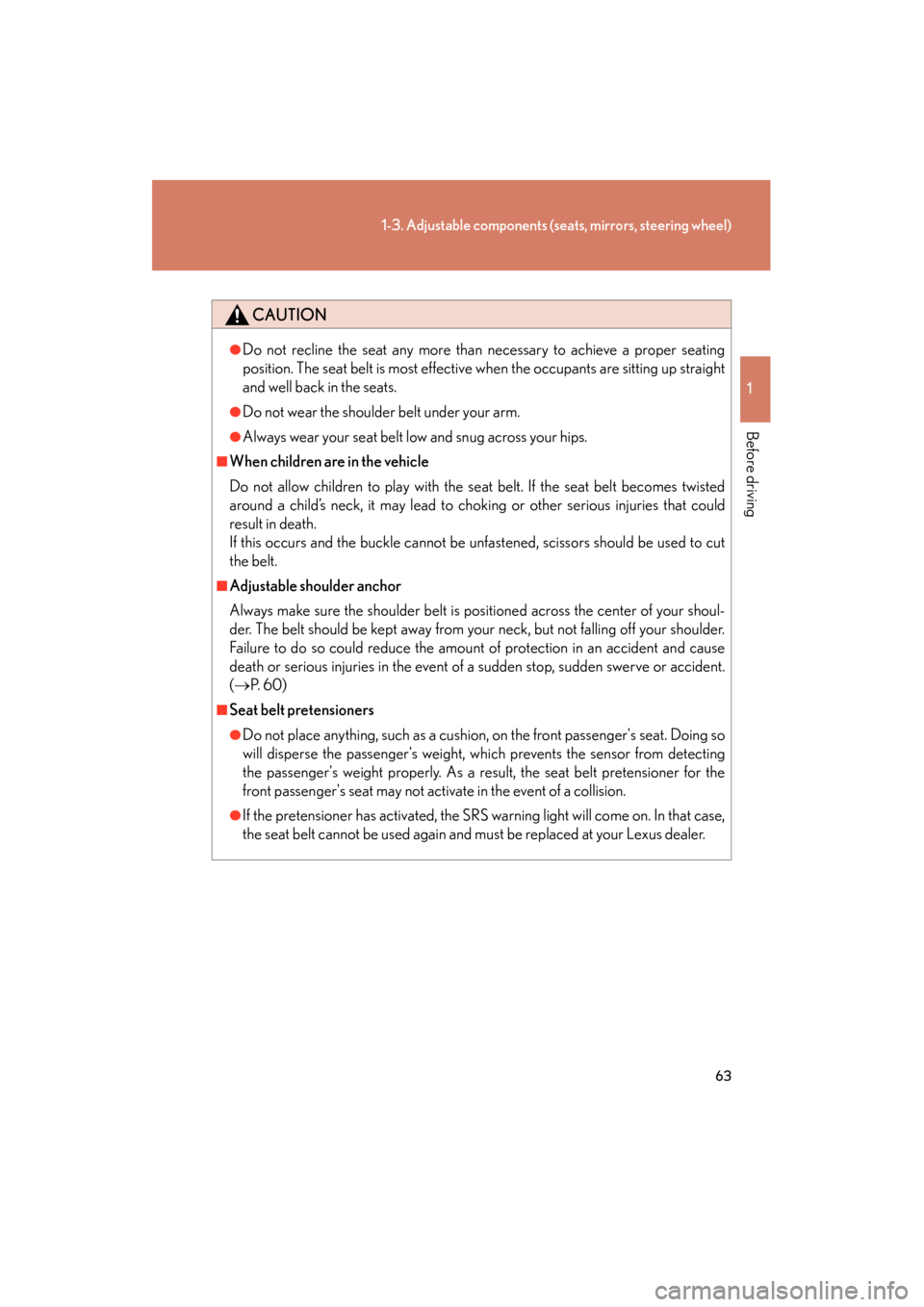
63
1-3. Adjustable components (seats, mirrors, steering wheel)
1
Before driving
ES350_U
CAUTION
●Do not recline the seat any more than necessary to achieve a proper seating
position. The seat belt is most effective when the occupants are sitting up straight
and well back in the seats.
●Do not wear the shoulder belt under your arm.
●Always wear your seat belt low and snug across your hips.
■When children are in the vehicle
Do not allow children to play with the seat belt. If the seat belt becomes twisted
around a child’s neck, it may lead to choking or other serious injuries that could
result in death.
If this occurs and the buckle cannot be unfastened, scissors should be used to cut
the belt.
■Adjustable shoulder anchor
Always make sure the shoulder belt is positioned across the center of your shoul-
der. The belt should be kept away from your neck, but not falling off your shoulder.
Failure to do so could reduce the amount of protection in an accident and cause
death or serious injuries in the event of a sudden stop, sudden swerve or accident.
(→ P. 60)
■Seat belt pretensioners
●Do not place anything, such as a cushion, on the front passenger's seat. Doing so
will disperse the passenger's weight, which prevents the sensor from detecting
the passenger's weight properly. As a result, the seat belt pretensioner for the
front passenger's seat may not activate in the event of a collision.
●If the pretensioner has activated, the SRS warning light will come on. In that case,
the seat belt cannot be used again and must be replaced at your Lexus dealer.
Page 67 of 554
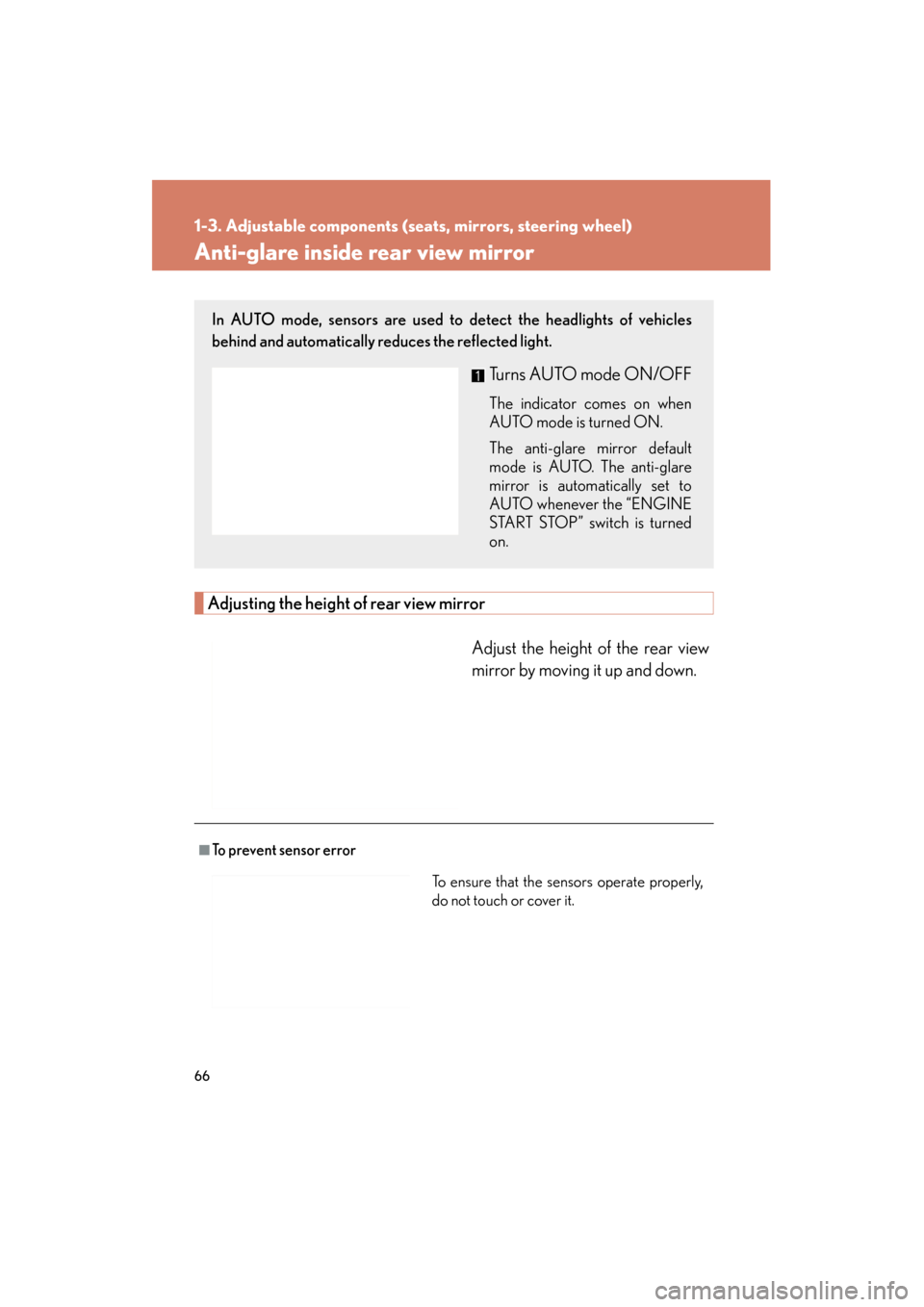
66
1-3. Adjustable components (seats, mirrors, steering wheel)
ES350_U
Anti-glare inside rear view mirror
Adjusting the height of rear view mirrorAdjust the height of the rear view
mirror by moving it up and down.
In AUTO mode, sensors are used to detect the headlights of vehicles
behind and automatically reduces the reflected light.
Turns AUTO mode ON/OFF
The indicator comes on when
AUTO mode is turned ON.
The anti-glare mirror default
mode is AUTO. The anti-glare
mirror is automatically set to
AUTO whenever the “ENGINE
START STOP” switch is turned
on.
■To prevent sensor errorTo ensure that the sensors operate properly,
do not touch or cover it.
Page 90 of 554
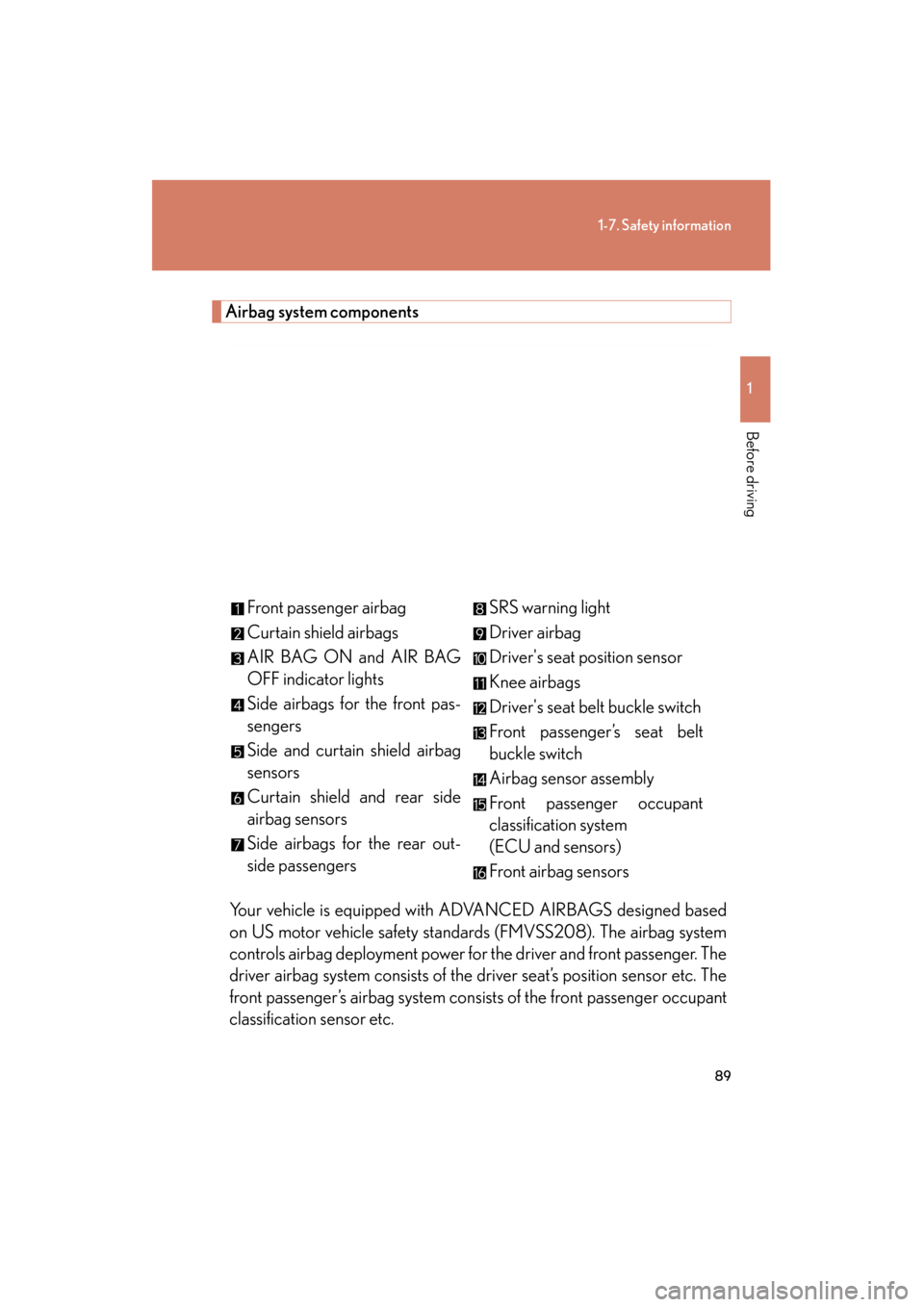
89
1-7. Safety information
1
Before driving
ES350_U
Airbag system componentsYour vehicle is equipped with ADVANCED AIRBAGS designed based
on US motor vehicle safety standards (FMVSS208). The airbag system
controls airbag deployment power for the driver and front passenger. The
driver airbag system consists of the driver seat’s position sensor etc. The
front passenger’s airbag system consists of the front passenger occupant
classification sensor etc. Front passenger airbag
Curtain shield airbags
AIR BAG ON and AIR BAG
OFF indicator lights
Side airbags for the front pas-
sengers
Side and curtain shield airbag
sensors
Curtain shield and rear side
airbag sensors
Side airbags for the rear out-
side passengers
SRS warning light
Driver airbag
Driver's seat position sensor
Knee airbags
Driver's seat belt buckle switch
Front passenger’s seat belt
buckle switch
Airbag sensor assembly
Front passenger occupant
classification system
(ECU and sensors)
Front airbag sensors
Page 91 of 554
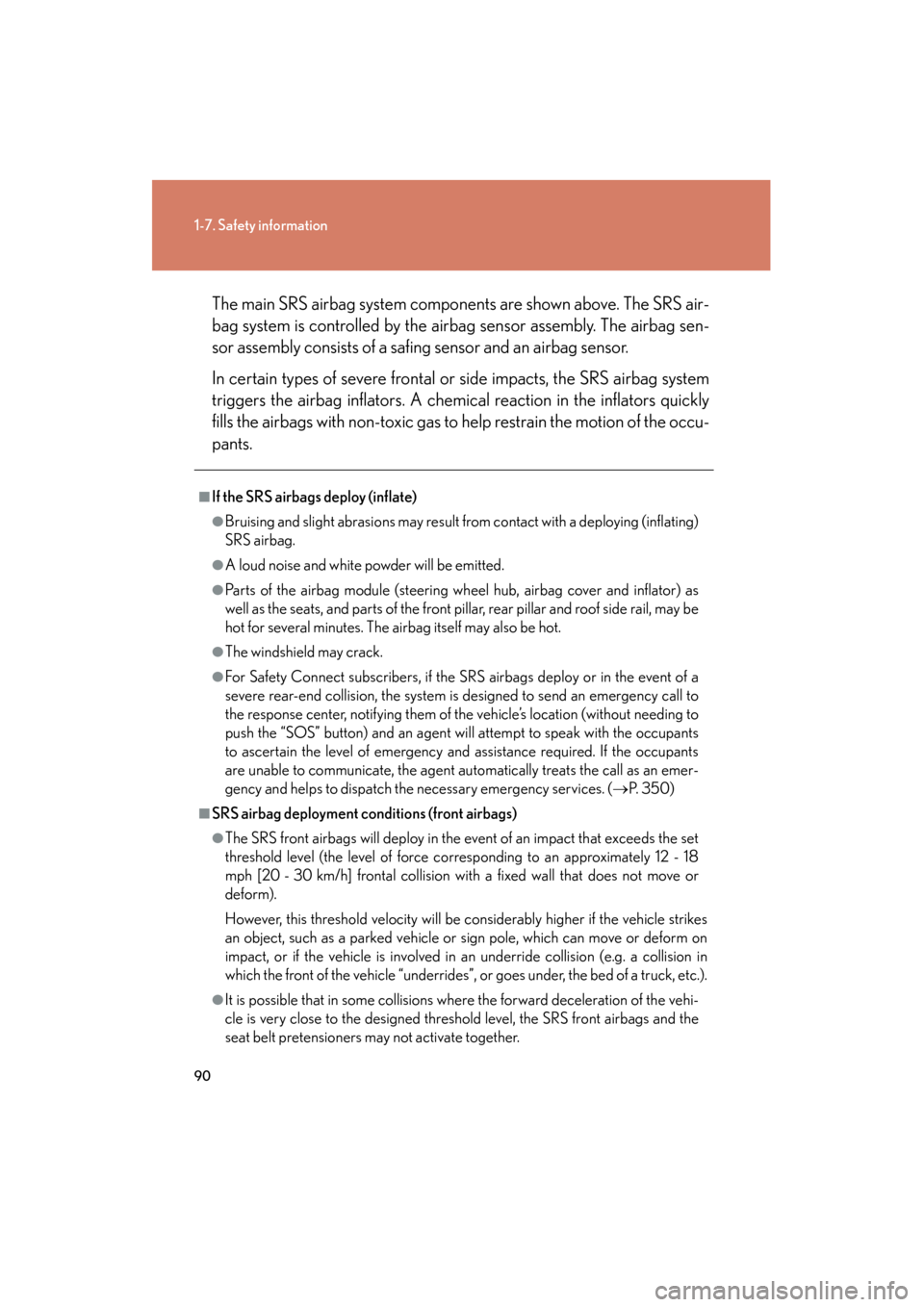
90
1-7. Safety information
ES350_UThe main SRS airbag system components are shown above. The SRS air-
bag system is controlled by the airbag sensor assembly. The airbag sen-
sor assembly consists of a safing sensor and an airbag sensor.
In certain types of severe frontal or side impacts, the SRS airbag system
triggers the airbag inflators. A chem
ical reaction in the inflators quickly
fills the airbags with non-toxic gas to help restrain the motion of the occu-
pants.
■If the SRS airbags deploy (inflate)
●Bruising and slight abrasions may result from contact with a deploying (inflating)
SRS airbag.
●A loud noise and white powder will be emitted.
●Parts of the airbag module (steering wheel hub, airbag cover and inflator) as
well as the seats, and parts of the front pillar, rear pillar and roof side rail, may be
hot for several minutes. The airbag itself may also be hot.
●The windshield may crack.
●For Safety Connect subscribers, if the SRS airbags deploy or in the event of a
severe rear-end collision, the system is designed to send an emergency call to
the response center, notifying them of the vehicle’s location (without needing to
push the “SOS” button) and an agent will attempt to speak with the occupants
to ascertain the level of emergency and assistance required. If the occupants
are unable to communicate, the agent automatically treats the call as an emer-
gency and helps to dispatch the necessary emergency services. ( →P. 3 5 0 )
■SRS airbag deployment conditions (front airbags)
●The SRS front airbags will deploy in the event of an impact that exceeds the set
threshold level (the level of force corresponding to an approximately 12 - 18
mph [20 - 30 km/h] frontal collision with a fixed wall that does not move or
deform).
However, this threshold velocity will be considerably higher if the vehicle strikes
an object, such as a parked vehicle or sign pole, which can move or deform on
impact, or if the vehicle is involved in an underride collision (e.g. a collision in
which the front of the vehicle “underrides”, or goes under, the bed of a truck, etc.).
●It is possible that in some collisions where the forward deceleration of the vehi-
cle is very close to the designed threshold level, the SRS front airbags and the
seat belt pretensioners may not activate together.
Page 153 of 554
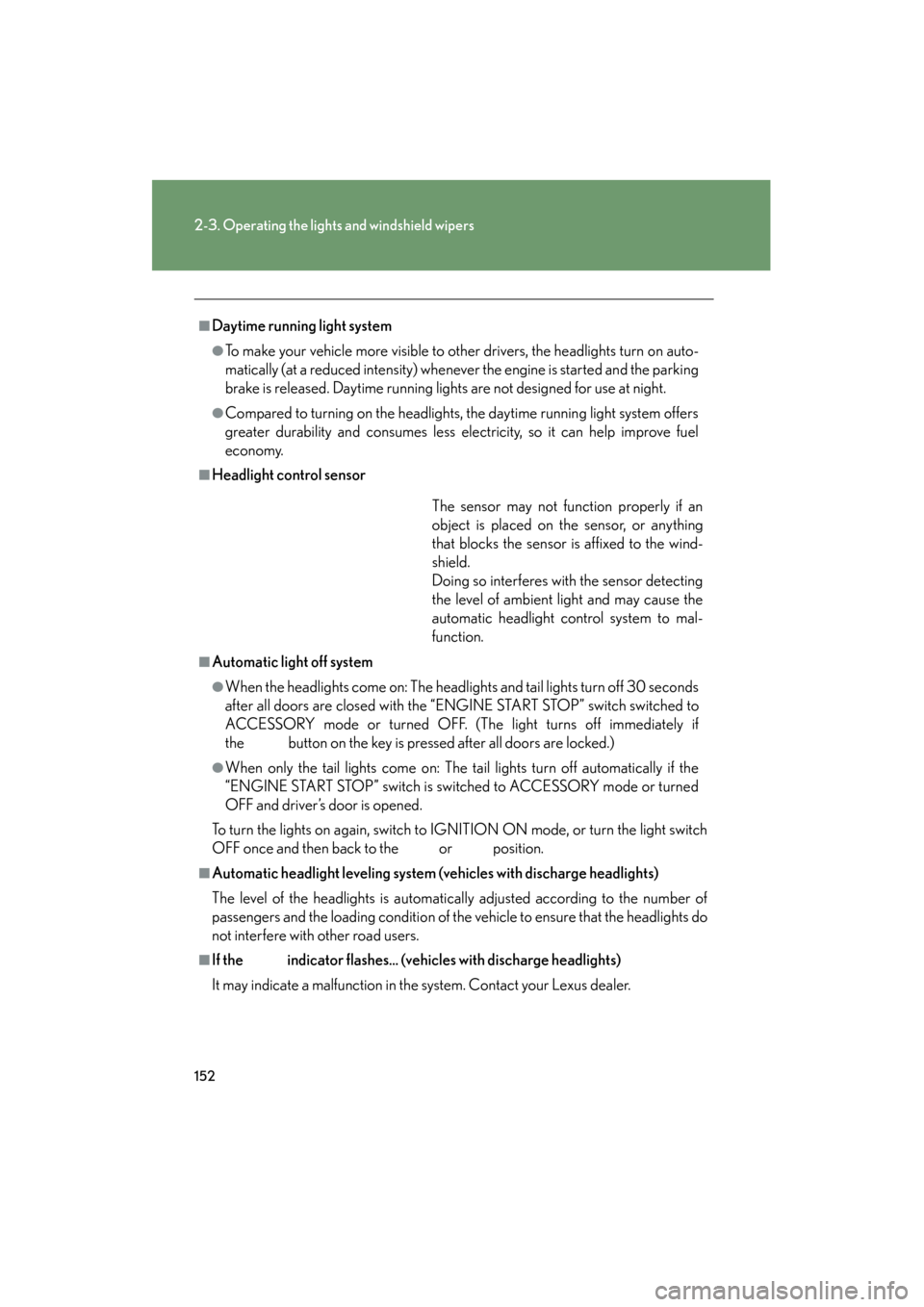
152
2-3. Operating the lights and windshield wipers
ES350_U
■Daytime running light system
●To make your vehicle more visible to other drivers, the headlights turn on auto-
matically (at a reduced intensity) whenever the engine is started and the parking
brake is released. Daytime running lights are not designed for use at night.
●Compared to turning on the headlights, the daytime running light system offers
greater durability and consumes less electricity, so it can help improve fuel
economy.
■Headlight control sensor
■Automatic light off system
●When the headlights come on: The headlights and tail lights turn off 30 seconds
after all doors are closed with the “ENGINE START STOP” switch switched to
ACCESSORY mode or turned OFF. (The light turns off immediately if
the button on the key is pressed after all doors are locked.)
●When only the tail lights come on: The tail lights turn off automatically if the
“ENGINE START STOP” switch is switched to ACCESSORY mode or turned
OFF and driver’s door is opened.
To turn the lights on again, switch to IGNITION ON mode, or turn the light switch
OFF once and then back to the
or position.
■Automatic headlight leveling system (vehicles with discharge headlights)
The level of the headlights is automatically adjusted according to the number of
passengers and the loading condition of the vehicle to ensure that the headlights do
not interfere with other road users.
■If the indicator flashes... (veh icles with discharge headlights)
It may indicate a malfunction in the system. Contact your Lexus dealer. The sensor may not function properly if an
object is placed on the sensor, or anything
that blocks the sensor is affixed to the wind-
shield.
Doing so interferes with the sensor detecting
the level of ambient light and may cause the
automatic headlight control system to mal-
function.
Page 154 of 554

153
2-3. Operating the lights and windshield wipers
2
When driving
ES350_U
■Customization that can be configured at Lexus dealer
Settings (e.g. light sensor sensitivity) can be changed.
(Customizable features →P. 5 1 1 )
NOTICE
■To prevent battery discharge
Do not leave the lights on longer than necessary when the engine is not running.
Page 157 of 554
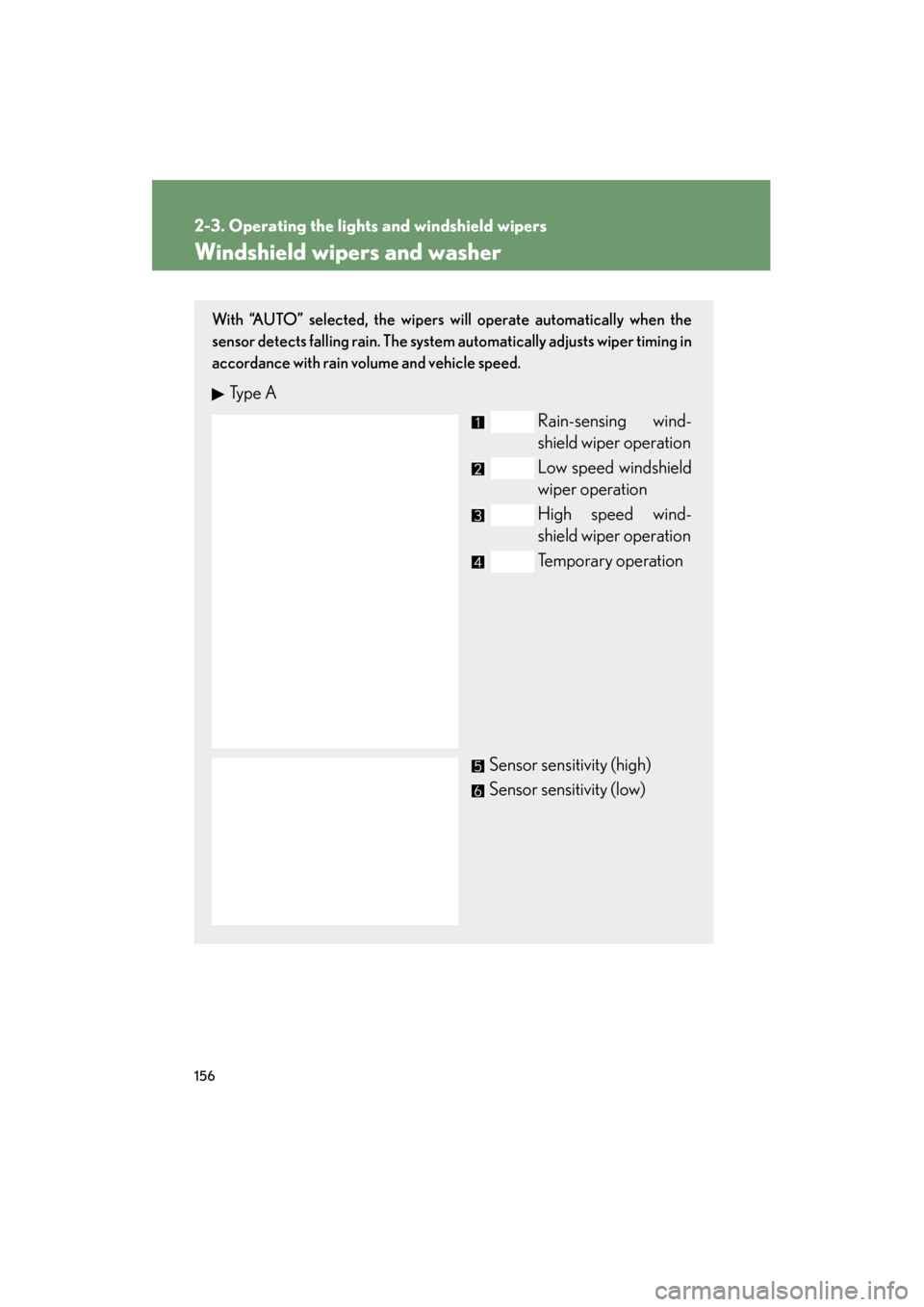
156
2-3. Operating the lights and windshield wipers
ES350_U
Windshield wipers and washer
With “AUTO” selected, the wipers will operate automatically when the
sensor detects falling rain. The system automatically adjusts wiper timing in
accordance with rain volume and vehicle speed.
Ty p e A
Rain-sensing wind-
shield wiper operation
Low speed windshield
wiper operation
High speed wind-
shield wiper operation
Temporary operation
Sensor sensitivity (high)
Sensor sensitivity (low)